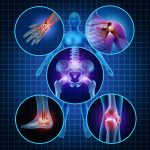When doctors suspect a person’s back pain is due to sacroiliac joint dysfunction, they may provide a treatment and diagnostic tool known as SI Joint Injections. The injections send anti-inflammatory pain relief medication into the problem area, helping the patient feel substantially better and improving function. This can help clear up pain in the lower back down through the legs and outward to the hips since the joint connects the pelvis to the spinal cord. Pain can even travel all the way to the foot. The chronic discomfort can become debilitating and lead the person to become very sedentary.
The shots include a local anesthetic that has short-term pain relief results; it numbs the area so nerve discomfort cannot be felt. In addition, the injection includes cortisone or for long-term relief. This corticosteroid medicine has strong anti-inflammatory effects that make them especially useful for back pain, and the decrease or elimination of pain can last for many months. If the patient only experiences moderate relief, the doctor may provide another injection some weeks later. This is relatively common, so patients should not become discouraged. Corticosteroid injections also are used for pain relief in other joints, as well as in muscles and tendons.
SI Joint Injections also act as a diagnostic device because if the patient doesn’t experience pain reduction, it indicates to the doctor that the problem is not with the sacroiliac joint. The treatment does not cure the physical problem with the joint but allows the patient to regain quality of life that has been negatively affected due to chronic discomfort. Eventually, an individual may need surgery on the joint, but many patients can avoid this altogether with successful anti-inflammatory injections.
A person dealing with chronic low back pain or discomfort below this area may want to set an appointment with a facility such as Aspire Pain Medical Center. A physician will evaluate the patient and determine whether an SI joint injection is advisable. With a more definitive diagnosis, the patient and his or her health care team can work on a plan of action for the future. The shots generally are part of a larger treatment plan and not the only focus. You can also follow them on Twitter for more updates.




